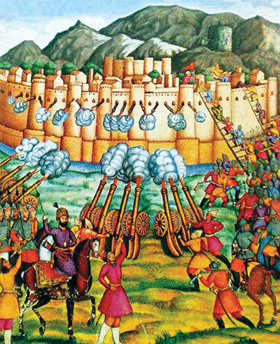Siege of Kandahar
| Siege of Kandahar | |||||||||
|---|---|---|---|---|---|---|---|---|---|
 Illustration of the siege |
|||||||||
|
|||||||||
| Belligerents | |||||||||
|
|
|
||||||||
| Commanders and leaders | |||||||||
|
Hussain Hotaki (POW) Mohammad Seidal Khan (POW) |
||||||||
| Strength | |||||||||
| Unknown | Tens of thousands | ||||||||
| Casualties and losses | |||||||||
| Unknown | All killed or captured | ||||||||
The April 1737 siege of Kandahar began when Nader Shah's Afsharid army invaded southern Afghanistan to topple the last Hotaki stronghold, which was held by Hussain Hotaki. It took place in the Old Kandahar area of the modern city of Kandahar in Afghanistan and lasted until March 24, 1738, when the Hotaki Afghans were defeated by the Persian army.
Hotaki was not a subject of Muhammad Shah, however a vast majority of his kinsmen did serve the Mughal Empire, thus the conflict had become a prelude of Nadir Shah's invasion.
Much of the duration of the siege saw little fighting as Nader's forces' lack of heavy artillery forced them to settle into a blockade of the fortified town. As the Persians became more impatient, they made several attempts to take the city by storm but the Afghans defiantly repulsed these attempts.
In anticipation of the siege, the Afghans had stockpiled large amounts of provisions in the fortified town and although starvation had begun to take hold by the end of 1737, Nader realized that it would take a long time for the Afghans to exhaust the last of their provisions. He was unsure of his position in Persia; although he had deposed Tahmasp II, the deposed ex-king was still alive and Nader did not want to remain bogged down in the siege. On March 23, 1738, Nader selected 3,000 men from among the Bakhtiari contingent of his troops to lead a human wave assault on Kandahar. A Bakhtiari named Mullah Adineh Mostafi was selected to lead the assault party.
Nader initially tried to dissuade the mullah from taking part in the attack given the threat he faced but Adineh insisted on taking part. The night before the attack, Nader personally addressed the Bakhtiaris and told them that they would each be given 1,000 rupees and a share of the spoils of the city if the assault succeeded. On March 24, the assault commenced and the Bakhtiaris surged forth from their concealed positions on the cliffs of Chehel Zina and charged towards the city. The Afghan gunners in the fortified city guard towers managed to kill some of the attackers but many of the Bakhtiaris reached the city walls and used their ladders to scale it. Mullah Adineh was the first to make it to the top and a fierce struggle took place atop the Kandahar city walls. Gradually, the Bakhtiaris managed to take control of the walls and proceeded to take the inner fortifications of the city. The attackers then raised guns atop the walls and used them to bombard the city.
...
Wikipedia
